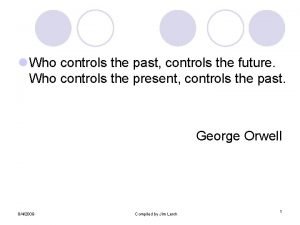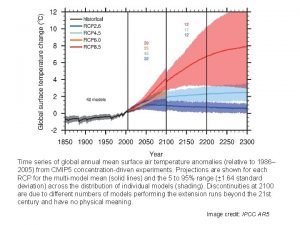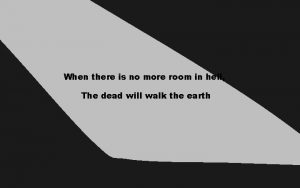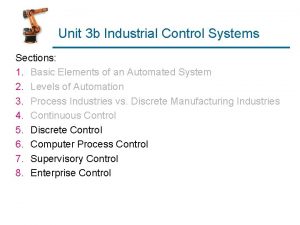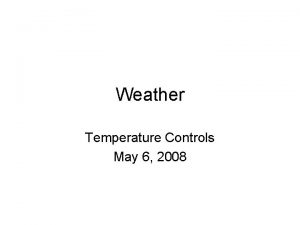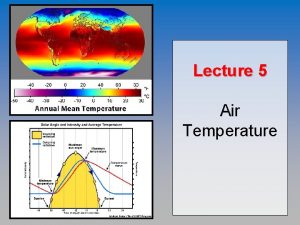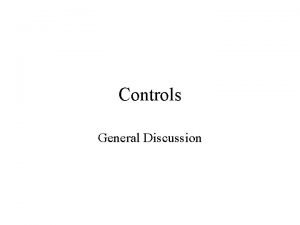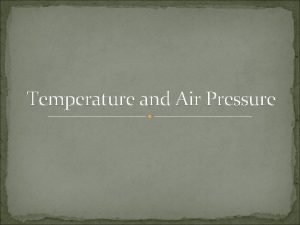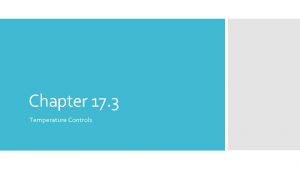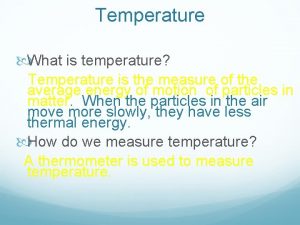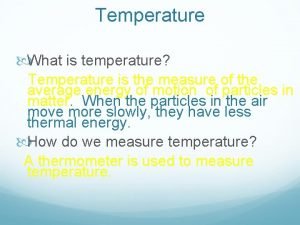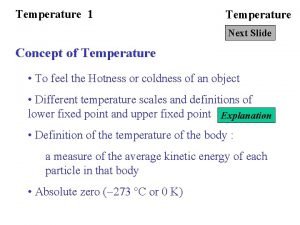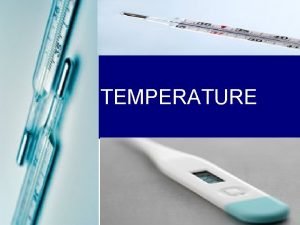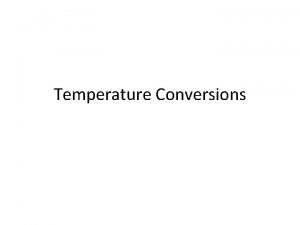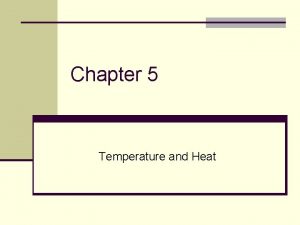Lecture 6 Air Temperature Applications WHAT CONTROLS AIR


















- Slides: 18

Lecture 6 Air Temperature & Applications

WHAT CONTROLS AIR TEMPERATURE? 1. Differential Heating of land water 2. Ocean Currents 3. Altitude 4. Geographic Position 5. Cloud cover and albedo

OCEAN CURRENTS • Ocean currents are caused by wind –interactions between the atmosphere and ocean • Energy passes from the atmosphere to the ocean via friction. –The DRAG exerted by the wind causes it to move

OCEAN CURRENTS – POLEWARD CURRENTS Have a MODERATING effect !! • Warm water from the tropics travels up the coast via the Gulf Stream • It becomes the North Atlantic Drift and helps keep English and Irish weather mild GULF STREAM!

ALTITUDE • Cooler temperatures at greater heights • Atmospheric pressure and density decreases, so that atmosphere absorbs and reflect less radiation.

GEOGRAPHIC POSITION l Leeward: prevailing winds blow TOWARDS ON the Ocean I CT ND WI RE I D C D IN W Lacks Ocean Influence, More like Land Temperatures MORE VARIABLE TEMPERATURES ON I T RE I D • Windward: prevailing winds blow From the Ocean to the SHORE Moderated by the Ocean air, cool summers-mild winters LESS VARIABLE TEMPERATURES

CLOUD COVER AND ALBEDO • Clouds cool during the day –High ALBEDO –Lower Maximum • Clouds warm at night –Trap OUTGOING Longwave radiation – Higher Minimum

WORLD DISTRIBUTION OF TEMPERATURES • Latitudinal Shifting due to the seasonal migration of the Sun. • “HOT SPOTS” –Differential heating • Heating is largely a function of LATITUDE JANUARY JULY

WORLD DISTRIBUTION OF TEMPERATURES • The hottest and coldest places are over land. • Warm ocean currents moving to the Poles warm the air. • Equatorial bound currents help cool the air.

WORLD DISTRIBUTION OF TEMPERATURES Equatorial temperatures do not fluctuate significantly (there are no seasons). Middle and higher latitudes have much stronger seasonal signals. -40 25 -10 25

APPLICATIONS OF TEMP DATA • Heating Degree-Days –When you turn the heat on • Cooling Degree-Days –When you turn the AC on • Growing Degree-Days –When plants can grow • Temperature and Comfort –How temperature ACTUALLY feels

TEMPERATURE AND COMFORT • How we perceive temperature matters to us humans. It is affected by: –Relative humidity –Wind –Sunshine • Heat Index –When it’s humid, evaporation doesn’t work as well and we “Feel” hotter • Windchill –Wind makes it “Feel” colder than it actually is

Temperature and Comfort

Isotherms • We use Isotherms the distribution of temperature over a large area. –They are lines that connect points on a map that have the same temperature

Isotherms – Why do we care? ? • Isotherms make it easier to read analyze weather maps • By looking at patterns of temperature (and pressure) you can determine weather conditions in the next few days.

Isotherm a Simplified Example

Let’s do an example together!

Let’s do an example together! 40 50 30 20 50 50 60 70 80 90 90
 General controls vs application controls
General controls vs application controls He who controls the past controls the future
He who controls the past controls the future What weather instrument measures air temperature
What weather instrument measures air temperature 01:640:244 lecture notes - lecture 15: plat, idah, farad
01:640:244 lecture notes - lecture 15: plat, idah, farad Difference between curie temperature and neel temperature
Difference between curie temperature and neel temperature Difference between curie temperature and neel temperature
Difference between curie temperature and neel temperature Ferromagnetis
Ferromagnetis Hubungan air tanah dan tanaman
Hubungan air tanah dan tanaman Brainpop precipitation
Brainpop precipitation When air rapidly expands its temperature normally
When air rapidly expands its temperature normally Global mean surface air temperature
Global mean surface air temperature What happens when the temperature of the air cools brainpop
What happens when the temperature of the air cools brainpop Brainpop weather
Brainpop weather Brainpop1
Brainpop1 When there is no more room in hell
When there is no more room in hell Screen based control
Screen based control Alert warning symbols and controls worksheet
Alert warning symbols and controls worksheet Direct digital controls
Direct digital controls Corrective controls examples
Corrective controls examples

